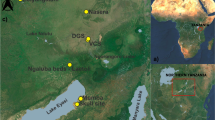Abstract
Analyses of the productions of della Robbia and Palissy, two masters of Renaissance ceramics in France and in Italy, have enlightened their contributions to the improvement of the glazed terracotta technique. Della Robbia used very homogeneous materials: marly clay for the bodies, and tin-opacified coloured glazes. The technique is here very robust and very mastered. Palissy used different types of clay with different colours and physical properties, associated with specific productions. So far, we have identified seven pastes. Concerning the glazes, he played with transparency and opacity, with lead glazes and with tin-opacified lead glazes. He added traditional colouring oxides as well as specific pigments (lead–tin yellow, haematite, etc.). The mixed-earth technique is specific to his palette. So, the materials used by both artists are completely different and illustrate their different philosophical approaches. To perform the different analyses, new methodologies have been developed: ICP/AES-MS, petrography and X-ray diffractometry for the bodies, PIXE and micro-PIXE, SEM coupled with EDS and Raman spectrometry for the glazes.
Similar content being viewed by others
References
J.R. Gaborit, M. Bormand: Les Della Robbia – Sculptures en Terre Cuite Émaillée de la Renaissance Italienne (Réunion des Musées Nationaux, Paris 2002)
C. Piccolpasso: The Three Books of the Potter’s Art (1557), 2 vols. [a facsimile of the manuscript in the Victoria and Albert Museum], ed. by R. Lightbown, A. Caiger-Smith (Scolar Press, London 1980)
B. Palissy: OEuvres Complètes, Edition de 1880 préfacée par A. France (Cheravay Frères, Paris 1880)
B. Dufay, Y. de Kish, D. Poulain, Y. Roumégaux, P.J. Trombetta: Rev. L’art 78, 33 (1987)
T. Calligaro, J.C. Dran, E. Ioannidou, B. Moignard, L. Pichon, J. Salomon: Nucl. Instrum. Methods Phys. Res. B 161, 328 (2000)
A. Zucchiatti, A. Bouquillon, J. Castaing, J.R. Gaborit: Archaeometry 45, 391 (2003)
A. Bouquillon, J. Castaing, J. Salomon, A. Zucchiatti et al.: in Conf. Fundamental and Applied Aspects of Modern Physics, Luderitz, ed. by S.H. Connell, R. Tegen (World Scientific, Singapore 2001) pp. 441–448
E. Faure: Histoire de L’Art – L’Art Renaissant (Le Livre de Poche, Paris 1964)
G. Gentilini: I Della Robbia, 2 Vols. (Cantini, Firenze 1992)
M.G. Vacari: ‘Tecniche e Metodi di Lavorazione’. In: I Della Robbia e L’‘Arte Nuova’ Della Scultura Invetriata (Guinti ed, Firenze 1998) pp. 97–116
M. Tite: ‘Technological Investigations of Italian Renaissance Ceramics’. In: Itialian Renaissance pottery, ed. by T. Wilson (London 1991) pp. 280–285
D. Poulain: Bull. Mus. Monuments Lyonnais 3–4, 24 (1993)
I. Perrin, B. Velde, D. Mac Arthur: Techné 6, 58 (1997)
A. Bouquillon, C. Pouthas: Key Eng. Mater. 132–136, 1487 (1997)
L. Amico: Bernard Palissy et ses Continuateurs – A la Recherche du Paradis Terrestre (Flammarion, Paris 1996)
Author information
Authors and Affiliations
Corresponding author
Additional information
PACS
82.80.-d; 81.05.Je; 61.43.Fs
Rights and permissions
About this article
Cite this article
Bouquillon, A. Heaven and Earth – ‘Madonne col Bambino’ and ‘Rustiques figulines’. Appl. Phys. A 79, 161–166 (2004). https://doi.org/10.1007/s00339-004-2507-3
Received:
Accepted:
Published:
Issue Date:
DOI: https://doi.org/10.1007/s00339-004-2507-3




